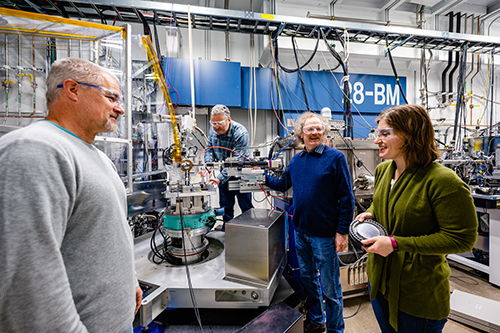
The Resonant Inelastic X-ray Scattering (RIXS) program at the Advanced Photon Source (APS), a U.S. Department of Energy Office of Science user facility at Argonne National Laboratory, is now running experiments using an enhanced spectrometer and high-resolution monochromator at beamline 27-ID. The new capabilities went online in March 2022, making 27-ID the first available beamline enhancement funded by the APS Upgrade Project.
The enhancement was very timely. The former two-decades-old instrument was not precise enough to fully capitalize on anticipated post-upgrade source improvements, such as measuring smaller samples and very thin films. It also lacked the flexibility to satisfy the growing trend of more diverse and extreme sample environments.
The spectrometer was re-designed, decoupling the motions of sample and analyzer and removing functions that have since become dispensable. The new spectrometer is consequently simpler mechanically, faster, more accurate and easier to operate than its predecessor. It also has more space to accommodate a wide variety of sample environments for in situ/operando measurements.
“The upgraded configuration makes the RIXS instrument an ideal place to perform experiments that require more complex scattering geometries and high accuracy," said Wei-Sheng Lee of Stanford University, who was one of the first users of the new instrument. Lee and his group performed RIXS measurements with both the old and upgraded instrument using grazing incidence RIXS on NdNiO2 films with thickness of only a few nanometers. This required high degrees of reproducibility and stability from the instrument, providing a stringent test for the new setup.
These improvements to the RIXS spectrometer were conceived of and implemented by physicists and staff scientists of the Inelastic X-ray and Nuclear Resonant Scattering (IXN) group in Argonne’s X-ray Sciences Division (XSD): Diego Casa, Jungho Kim, Thomas Gog, Ayman Said, Thomas Toellner, and Mary Upton. Critical engineering support was rendered by Scott Coburn of Brookhaven National Laboratory. The pandemic hit just as the implementation phase was getting started, but the team quickly adapted to virtual meetings and other remote work tools to plan and coordinate installation of new components within COVID safety protocols.
RIXS is ideal for studying electronic excitations in a wide range of complex materials, which give rise to exotic phenomena expected to power advanced devices and shape the next generation of technological innovations. Scientists have designed this spectrometer to reach unprecedented count rates and energy resolution that will continue to advance discoveries in materials science and the future of quantum computing.
In the more distant post-upgrade future, the newly enhanced RIXS instrument will accommodate next-generation, quartz-based, curved crystal optics, as well as ultra-high resolution flat-crystal assemblies that were recently developed and tested by the IXN group. With these novel optics, the IXN group currently holds the world record in energy resolution of any RIXS measurement ever performed.
The first functioning enhanced beamline funded by the APS Upgrade project is the result of hard work, creativity, expertise and dedication by many. Scientific Associates Rick Krakora and Emily Aran, collaborators within the IXN group, contributed significantly. The RIXS enhancement benefitted further from contributions of Xianrong Huang, Jeff Kirchman and Sunil Bean of APS.
“We are excited to bring this new generation of RIXS instrumentation to our user community, and they are also excited in anticipation of new science,” said Gog, physicist and group leader with XSD. ― Kristen Mally Dean
The Advanced Photon Source is a DOE Office of Science User Facility operated for the DOE Office of Science by Argonne National Laboratory under Contract No. DE-AC02-06CH11357
The U.S. Department of Energy's APS at Argonne National Laboratory is one of the world’s most productive x-ray light source facilities. Each year, the APS provides high-brightness x-ray beams to a diverse community of more than 5,000 researchers in materials science, chemistry, condensed matter physics, the life and environmental sciences, and applied research. Researchers using the APS produce over 2,000 publications each year detailing impactful discoveries, and solve more vital biological protein structures than users of any other x-ray light source research facility. APS x-rays are ideally suited for explorations of materials and biological structures; elemental distribution; chemical, magnetic, electronic states; and a wide range of technologically important engineering systems from batteries to fuel injector sprays, all of which are the foundations of our nation’s economic, technological, and physical well-being.
Argonne National Laboratory seeks solutions to pressing national problems in science and technology. The nation's first national laboratory, Argonne conducts leading-edge basic and applied scientific research in virtually every scientific discipline. Argonne researchers work closely with researchers from hundreds of companies, universities, and federal, state and municipal agencies to help them solve their specific problems, advance America's scientific leadership and prepare the nation for a better future. With employees from more than 60 nations, Argonne is managed by UChicago Argonne, LLC, for the U.S. DOE Office of Science.
The U.S. Department of Energy's Office of Science is the single largest supporter of basic research in the physical sciences in the United States and is working to address some of the most pressing challenges of our time. For more information, visit the Office of Science website.
